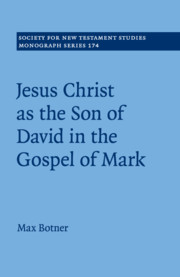Book contents
- Jesus Christ as the Son of David in the Gospel of Mark
- Society for New Testament Studies Monograph Series
- Jesus Christ as the Son of David in the Gospel of Mark
- Copyright page
- Epigraph
- Contents
- Acknowledgments
- Abbreviations
- 1 The Son of David and the Christ of Mark
- 2 The Makings of a Messiah
- 3 Christening Jesus of Nazareth
- 4 How a Galilean Prophet Becomes a Messiah like David
- 5 The Son of David and the Jerusalem Temple
- 6 Crucifixion and Resurrection as a Markan Hermeneutic
- 7 Conclusion
- Bibliography
- Index of Ancient Sources
- Index of Modern Authors
- Index of Subjects
- References
Bibliography
Published online by Cambridge University Press: 16 May 2019
- Jesus Christ as the Son of David in the Gospel of Mark
- Society for New Testament Studies Monograph Series
- Jesus Christ as the Son of David in the Gospel of Mark
- Copyright page
- Epigraph
- Contents
- Acknowledgments
- Abbreviations
- 1 The Son of David and the Christ of Mark
- 2 The Makings of a Messiah
- 3 Christening Jesus of Nazareth
- 4 How a Galilean Prophet Becomes a Messiah like David
- 5 The Son of David and the Jerusalem Temple
- 6 Crucifixion and Resurrection as a Markan Hermeneutic
- 7 Conclusion
- Bibliography
- Index of Ancient Sources
- Index of Modern Authors
- Index of Subjects
- References
- Type
- Chapter
- Information
- Jesus Christ as the Son of David in the Gospel of Mark , pp. 195 - 220Publisher: Cambridge University PressPrint publication year: 2019



